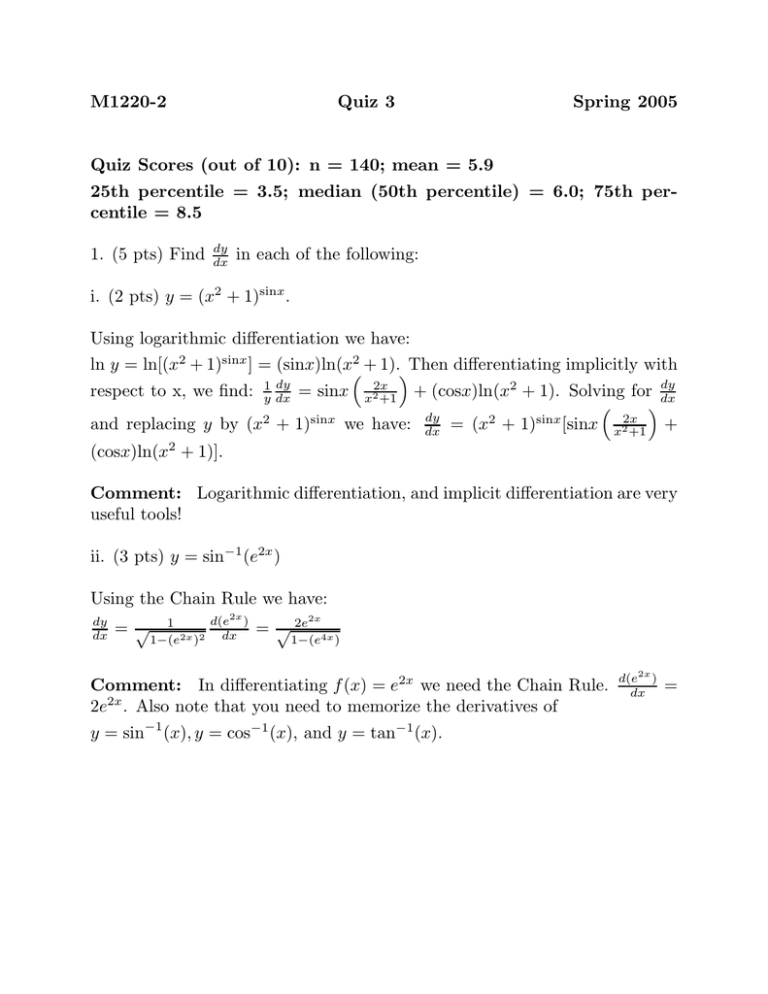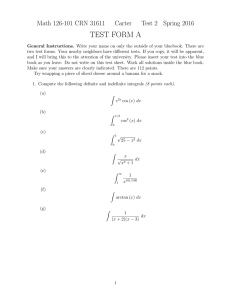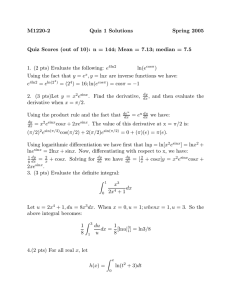M1220-2 Quiz 3 Spring 2005
advertisement

M1220-2 Quiz 3 Spring 2005 Quiz Scores (out of 10): n = 140; mean = 5.9 25th percentile = 3.5; median (50th percentile) = 6.0; 75th percentile = 8.5 1. (5 pts) Find dy dx in each of the following: i. (2 pts) y = (x2 + 1)sinx . Using logarithmic differentiation we have: 2 ln y = ln[(x2 + 1)sinx ] = (sinx)ln(x + 1).Then differentiating implicitly with dy dy 2 respect to x, we find: y1 dx = sinx x22x +1 + (cosx)ln(x + 1). Solving for dx dy 2x 2 sinx 2 sinx and replacing y by (x + 1) we have: dx = (x + 1) [sinx x2 +1 + (cosx)ln(x2 + 1)]. Comment: Logarithmic differentiation, and implicit differentiation are very useful tools! ii. (3 pts) y = sin−1 (e2x ) Using the Chain Rule we have: dy dx = √ d(e2x ) 1 1−(e2x )2 dx 2x = √ 2e 1−(e4x ) Comment: In differentiating f (x) = e2x we need the Chain Rule. 2e2x . Also note that you need to memorize the derivatives of y = sin−1 (x), y = cos−1 (x), and y = tan−1 (x). d(e2x ) dx = 2. (3 pts) Evaluate the following definite integral. Z π/2 0 sinx dx 1 + cos2 x . If we let u = cosx, then du = −sinxdx. Note that u = 1, when x = 0, and u =, when x = π/2. The above integral becomes: Z 0 π/2 sinx dx = − 1 + cos2 x Z 0 1 1 = −arctanu|01 = −arctan(0) + arctan(1) 2 1 + u du . Since arctan(0) = 0, arctan(1) = π/4, the above intergral equals π/4. Comment: If you let u = 1 + cos2 x, then du = 2cosxsinxdx. 3. (2 pts) Suppose that function of x. dy dx + 2y = 3 and that y = 1 when x = 0. Find y as a dy with P (x) = 2. The above equation R R is of the form, dx + P(x)y = Q(x) 2x Since P(x)dx = 2dx = 2x, the integrating factor is e . Multiplying the differential equation on both sides by this integrating factor we get: 2x ) 3eR2x , or d(ye = 3e2x . Integrating both sides of the equation dx we have: ye = 3e2x dx = (3/2)e2x + C, C a constant. If we replace y by 1, and x by 0, then we get C = -1/2 and solving for y we have ye2x = (3/2) − (1/2)e−2x . dy 2x 2x = dx e +2ye 2x R Comment: Note that 3e2x dx = 32 e2x . Remember that you can check your answer quickly in a small integral like this by simply differentiating. If you R 2x ) had 3e2x dx = 6e2x , then differentiating, you’d get d(6e = 6[2e2x ] = 12e2x dx and you know that you were off by a constant.


